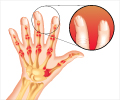Nanoparticle injections into injured joints may be effective in controlling the pain and inflammation of osteoarthritis, by reducing destruction of joint cartilage.
Highlights
- Osteoarthritis is a degenerative joint disease affecting many individuals globally
- It is associated with pain and inflammation due to degeneration of joint cartilage
- Present modalities of treatment don’t prevent cartilage degeneration.
- Nanoparticle remained in joints for weeks, halted cartilage destruction, and also controlled pain and inflammation.
Reasons for This Study
Osteoarthritis is a painful and crippling disease affecting nearly 27 million people in the United States alone, and at least 12 percent of osteoarthritis cases occur due to joint injuries sustained earlier.At present treatments involve the use of anti-inflammatory drugs and painkillers, which don’t halt joint cartilage destruction. Also their duration of action is shortlived, and their use is limited by side effects. Steroid injections into joints are also administered, but again, their effects are shortlived.
Researchers at Washington University School of Medicine in St. Louis have been able to demonstrate that injecting nanoparticles into injured joints in mice can effectively control pain and inflammation, and most importantly halt destruction of joint cartilage.
“I see a lot of patients with osteoarthritis, and there’s really no treatment,” said senior author Christine Pham, MD, an associate professor of medicine. “We try to treat their symptoms, but even when we inject steroids into an arthritic joint, the drug only remains for up to a few hours, and then it’s cleared. These nanoparticles remain in the joint longer and help prevent cartilage degeneration.”
Details of The Study
The nanoparticles that have been used in this study are very tiny (more than 10 times tinier than a red blood cell), a property that makes it easier for them to penetrate deeply into tissues. These particles contain a peptide derived from a natural protein called melittin which has been altered to enable it to attach to a molecule called small interfering RNA (siRNA). The melittin delivers siRNA to the damaged joint and controls the inflammation within the joint.The peptide-based nanoparticle was created by study co-investigators Hua Pan, PhD, an assistant professor of medicine, and Samuel Wickline, MD, the James R. Hornsby Family Professor of Biomedical Sciences.
Scope of The Study
In many cases, patients with osteoarthritis have suffered an earlier injury to the joint such as a fall, an accident, or a meniscal or ligament tear. The ensuing inflammation contributes to destruction of the cartilage.According to one of the researchers, more work is necessary to determine if nanoparticle injections are effective in cases of established osteoarthritis with cartilage destruction and loss.
Another investigator participating in the study, however feels that nanoparticles will prove effective even in advanced cases. “The inflammatory molecule that we’re targeting not only causes problems after an injury, but it’s also responsible for a great deal of inflammation in advanced cases of osteoarthritis,” said Linda J. Sandell, PhD, the Mildred B. Simon Research Professor of Orthopaedic Surgery and director of Washington University’s Center for Musculoskeletal Research. “So we think these nanoparticles may [also] be helpful in patients who already have arthritis, and we’re working to develop experiments to test that idea.”
In conclusion, it may be said that nanoparticle injections to treat osteoarthritis is a huge step forward, and if found effective in halting disease progression, could be life changing for many patients crippled by this disease.
Living with Osteoarthritis
At present, there is no cure for osteoarthritis, also known as ‘wear and tear’ joint disease. It is a crippling condition characterized by severe pain and limitation of mobility. It frequentlyinvolves hips, spine, knees, joints of hands and great toe. Some tips to cope with this condition include
- Proper positioning and support for neck and back.
- Adjusting furnitures, such as raising a chair or toilet seat.
- Avoid repeated motions of the joint, especially frequent bending.
- Following aregular exercise regimen, since exercise is good for joints.
- Weight loss in obese patients can prevent progression of disease.
- Using aids such as cane or walking stick to prevent falling.
- Working with a physiotherapist to improve range of motion and joint mobility.
- Osteoarthritis - Fast Facts - (http://www.rheumatology.org/I-Am-A/Patient-Caregiver/Diseases-Conditions/Osteoarthritis)
Source-Medindia















